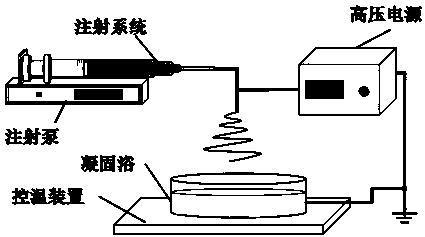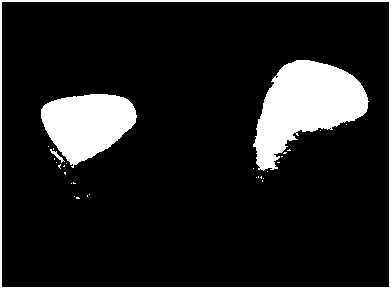A nanofibrous tissue filler and its preparation method
A technology of nanofibers and fillers, applied in the fields of surgery, medical science, etc., can solve the problems of easy deformation, difficult to support, and it is difficult for tissue fluid to infiltrate the stent.
- Summary
- Abstract
- Description
- Claims
- Application Information
AI Technical Summary
Problems solved by technology
Method used
Image
Examples
Embodiment 1
[0055] S1. Add 0.8g of polylactic acid into 10ml of hexafluoroisopropanol solution, stir at room temperature until dissolved, and make 8% (w / v) spinning solution; add 10g of gelatin into 100ml of deionized water, heat to 40 Stir until dissolved at ℃ to make a 10% (w / v) treatment solution; add 500ml of absolute ethanol to the crystallization dish and heat to 55℃ as a coagulation bath;
[0056] S2. If figure 1 As shown, add the spinning solution into the syringe, add an extension tube to the front end of the syringe and connect a 20G needle, place the syringe on the micro-injection pump, the needle is perpendicular to the crystallization dish, and the lower part of the crystallization dish is grounded; set the injection rate to 2ml / h, When the solution is extruded from the needle tip, a voltage of 18kv is applied to the needle tip; at this time, nanofibers are ejected and collected in the coagulation bath; when the collected nanofiber cluster reaches a certain amount, the voltag...
Embodiment 2
[0062] S1. Add 0.6g of polycaprolactone into 10ml of hexafluoroisopropanol solution, stir at room temperature until dissolved to make a 6% (w / v) spinning solution; add 1g of hyaluronic acid into 100ml of deionized water , stir until dissolved, then add 2g of antibiotic ceftriaxone sodium powder to the treatment solution to make a treatment solution with a hyaluronic acid concentration of 1% (w / v) and a ceftriaxone sodium concentration of 20mg / ml; 500ml of absolute ethanol Add it to a crystallization dish and heat it to 55°C as a coagulation bath;
[0063] S2. If figure 1 As shown, add the spinning solution into the syringe, add an extension tube to the front end of the syringe and connect a 20G needle, place the syringe on the micro-injection pump, the needle is perpendicular to the crystallization dish, and the lower part of the crystallization dish is grounded; set the injection rate to 3ml / h, When the solution is squeezed out from the needle tip, a voltage of 20kv is appli...
Embodiment 3
[0068] S1. Add 0.8g of polylactic acid into 10ml of hexafluoroisopropanol solution, stir at room temperature until dissolved, and make 8% (w / v) spinning solution; add 10g of gelatin into 100ml of deionized water, heat to 40 Stir at ℃ until dissolved, then dissolve 1g of sodium alginate in the above treatment solution, the concentration of gelatin in the final treatment solution is 10% (w / v), the concentration of sodium alginate is 1% (w / v); 5g Calcium chloride was dissolved in 95ml of deionized water to make a gel solution; 500ml of absolute ethanol was added to the crystallization dish and heated to 55°C as a coagulation bath;
[0069] S2. If figure 1 As shown, add the spinning solution into the syringe, add an extension tube to the front end of the syringe and connect a 20G needle, place the syringe on the micro-injection pump, the needle is perpendicular to the crystallization dish, and the lower part of the crystallization dish is grounded; set the injection rate to 2ml / h,...
PUM
| Property | Measurement | Unit |
|---|---|---|
| diameter | aaaaa | aaaaa |
| diameter | aaaaa | aaaaa |
| density | aaaaa | aaaaa |
Abstract
Description
Claims
Application Information
 Login to View More
Login to View More - R&D
- Intellectual Property
- Life Sciences
- Materials
- Tech Scout
- Unparalleled Data Quality
- Higher Quality Content
- 60% Fewer Hallucinations
Browse by: Latest US Patents, China's latest patents, Technical Efficacy Thesaurus, Application Domain, Technology Topic, Popular Technical Reports.
© 2025 PatSnap. All rights reserved.Legal|Privacy policy|Modern Slavery Act Transparency Statement|Sitemap|About US| Contact US: help@patsnap.com



